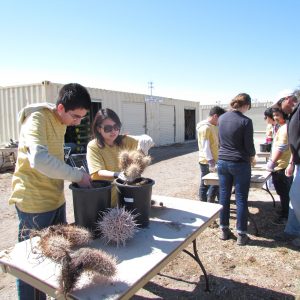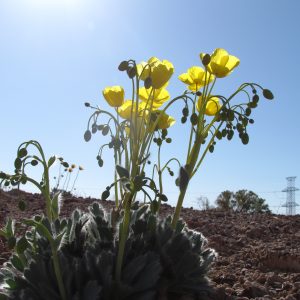There is something remarkable about the contrast of the burnt finger-like remnants of a stand of willow trees sticking out of blackened soil in a snow-covered creek. Despite this ominous view, if you look close enough, new life can be seen sprouting through the snow and along our trodden path. Thanks in part to reseeding efforts, these feeble patches of green will grow strong and help to stabilize soils and recolonize this burnt landscape. For four days we’ve been hiking up and down a beautiful canyon with amazing views of a small farming and ranching valley shrouded in a ring of mountains. The reason: public concerns that the erosion of the stream in this canyon on Bureau of Land Management land will lead to flooding and damage to adjacent homes and properties. To minimize the erosion and prevent the flooding, we are trying to establish a new stand of willow trees in highly eroded areas near their burnt relatives. To do this, we hike past the fire into un-burnt areas and collect cuttings of healthy willows. After packaging and burying them, we leave them for a couple months to induce root formation. Ultimately we will dig them up and plant the willows in dense stands. We have already managed to collect four-thousand willow cuttings, not the mention the cuttings we’ve been working on at other fire-affected sites.
In addition to the remarkable views, fun willow cutting experiences, and surreal burnt landscapes, the past few weeks have also been full of road trips to Salt Lake City and Chico for training. In Salt Lake City, we attended a five day long pesticide applicator and integrated pest management training session. This was a great opportunity to learn more about weed science, integrated pest management, and biocontrol, among other topics. As someone who has considered integrated pest management as a potential area of study in graduate school, I was fascinated by this training and incredibly happy to have the opportunity to hear about its application in real-world scenarios. It was also a great opportunity to connect with the other interns over dinner or while playing in the snow on our nightly walks back to the hostel. To finish up this week, we drove home, spent one night in our own beds, and woke up before the crack of dawn to drive to Chico and attend a class on lichen identification. This training was totally worth the early morning wake up call. Now we now longer have to wonder what the bright green and orange crusts on the rocks are, we have been given the tools to identify then and understand the physiology of these fascinating organisms.

Oh! and I can’t forget to mention, we also saw wild horses!!!

Lauren
Carson City, Nevada







